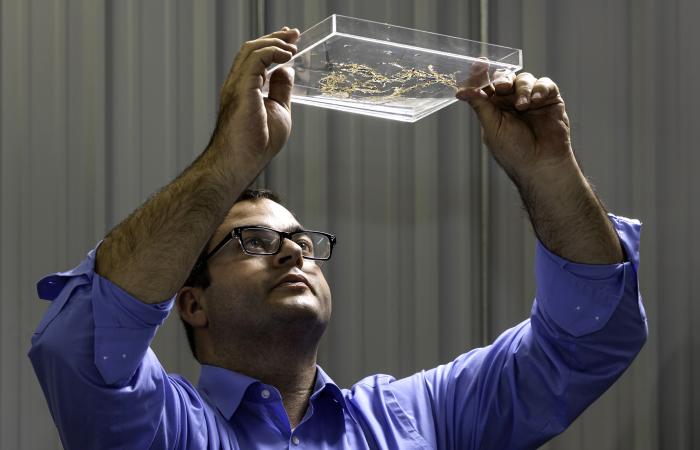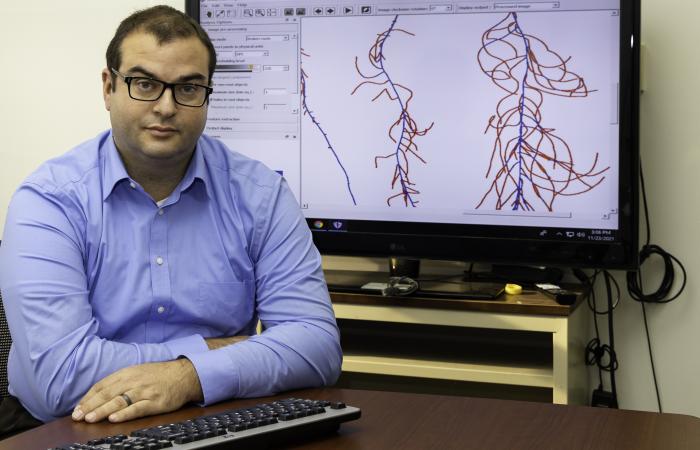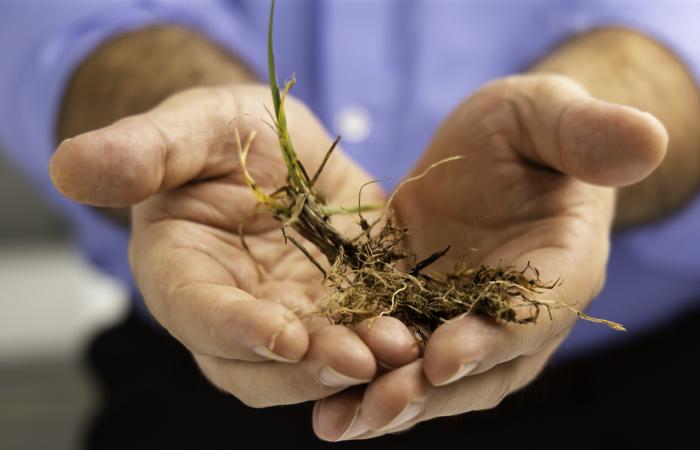-

ORNL's Larry York studies how plant root traits contribute to crop productivity. Credit: Carlos Jones/ORNL, U.S. Dept. of Energy
-

Root biologist Larry York developed easy-to-use image analysis software that accurately measures plant roots. Credit: Carlos Jones/ORNL, U.S. Dept. of Energy
-

Roots are critical to plant health as they facilitate the uptake of water and nutrients. Credit: Carlos Jones/ORNL, U.S. Dept. of Energy
-

ORNL's Larry York studies how plant root traits contribute to crop productivity. Credit: Carlos Jones/ORNL, U.S. Dept. of Energy
-

Root biologist Larry York developed easy-to-use image analysis software that accurately measures plant roots. Credit: Carlos Jones/ORNL, U.S. Dept. of Energy
-

Roots are critical to plant health as they facilitate the uptake of water and nutrients. Credit: Carlos Jones/ORNL, U.S. Dept. of Energy
Biologist Larry York's fascination with plant roots has spurred his research across four continents and inspired him to create accessible tools that enable others to explore the underground world.
As a plant physiologist at Oak Ridge National Laboratory, York examines the ways roots take up nutrients, looking for traits that improve crop productivity. His research has centered mainly on corn, soybeans and wheat with a more recent focus on bioenergy crops such as switchgrass and poplar.
"The more I work with roots, the more fascinated I become," York said. "They are important for many reasons, and there's a growing acknowledgement of their influence on soil carbon storage and climate change."
One of York's recent studies for the Center for Bioenergy Innovation at ORNL examined how switchgrass roots change in response to water and nitrogen deficits. The research team took advantage of ORNL's long history of working with stable isotopes to measure the contribution of roots to plant growth.
Using a stable isotope of nitrogen, they showed that plants with deeper roots took up more nitrogen and that stressed plants grow finer, lateral-branching roots to forage for scarce nutrients. Understanding these root traits and behaviors can aid efforts to develop hardier, more drought resistant crops.
Much of York's research involves digging up plants and measuring important root traits such as length and diameter. This is no easy feat as many roots are fragile, with some as fine as a human hair.
York had noted the lack of an easy-to-use solution for imaging roots and analyzing those images during his early studies. He filled that gap by creating RhizoVision Explorer during his time working at Noble Research Institute. Used with a flatbed scanner, this free software has quickly become a go-to technology for measuring roots.
"It allows more people to study roots than ever before," York said. "That's exciting to me, because I feel like I'm magnifying my impact by getting the software into the hands of anybody who wants to study roots."
"How many good ideas must there be out there for how we can use roots to increase crop productivity or build soil carbon?" he continued. "Now there are thousands of additional scientists who maybe weren't traditionally root biologists who are able to investigate these topics, too."
Imaging has been a thread running throughout York's research, and he has hosted numerous in-person and virtual workshops to teach others how to image and measure roots. He is particularly excited about the newest imaging capability at ORNL, the Advanced Plant Phenotyping Laboratory. Currently in the commissioning phase, this unique lab holds a diverse array of imaging capabilities for measuring plant growth characteristics.
York is contributing to a project that will extend the application of these imaging capabilities to belowground as well. Having these real-time data will facilitate connecting traits to underlying genetics and plant performance, informing design of better crops.
Digging in
Though he's always loved science and plants, York did not originally set out to study roots. Many family members, including his grandmother and aunt, influenced him through their careers in math and science. When he began his undergraduate studies at the University of Kentucky, York thought to emulate his uncle and pursue a degree in physics.






